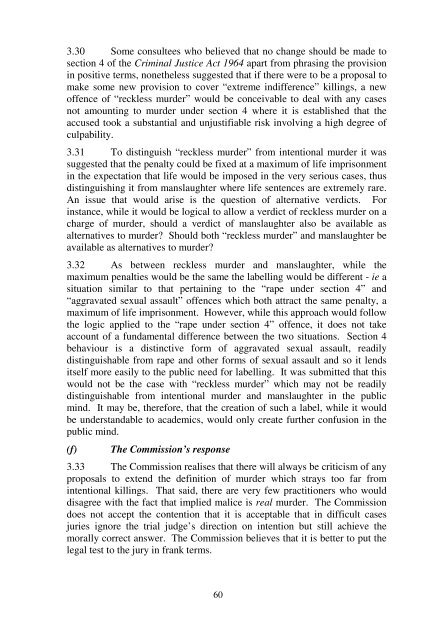murder and involuntary manslaughter - Law Reform Commission
murder and involuntary manslaughter - Law Reform Commission
murder and involuntary manslaughter - Law Reform Commission
Create successful ePaper yourself
Turn your PDF publications into a flip-book with our unique Google optimized e-Paper software.
3.30 Some consultees who believed that no change should be made tosection 4 of the Criminal Justice Act 1964 apart from phrasing the provisionin positive terms, nonetheless suggested that if there were to be a proposal tomake some new provision to cover “extreme indifference” killings, a newoffence of “reckless <strong>murder</strong>” would be conceivable to deal with any casesnot amounting to <strong>murder</strong> under section 4 where it is established that theaccused took a substantial <strong>and</strong> unjustifiable risk involving a high degree ofculpability.3.31 To distinguish “reckless <strong>murder</strong>” from intentional <strong>murder</strong> it wassuggested that the penalty could be fixed at a maximum of life imprisonmentin the expectation that life would be imposed in the very serious cases, thusdistinguishing it from <strong>manslaughter</strong> where life sentences are extremely rare.An issue that would arise is the question of alternative verdicts. Forinstance, while it would be logical to allow a verdict of reckless <strong>murder</strong> on acharge of <strong>murder</strong>, should a verdict of <strong>manslaughter</strong> also be available asalternatives to <strong>murder</strong>? Should both “reckless <strong>murder</strong>” <strong>and</strong> <strong>manslaughter</strong> beavailable as alternatives to <strong>murder</strong>?3.32 As between reckless <strong>murder</strong> <strong>and</strong> <strong>manslaughter</strong>, while themaximum penalties would be the same the labelling would be different - ie asituation similar to that pertaining to the “rape under section 4” <strong>and</strong>“aggravated sexual assault” offences which both attract the same penalty, amaximum of life imprisonment. However, while this approach would followthe logic applied to the “rape under section 4” offence, it does not takeaccount of a fundamental difference between the two situations. Section 4behaviour is a distinctive form of aggravated sexual assault, readilydistinguishable from rape <strong>and</strong> other forms of sexual assault <strong>and</strong> so it lendsitself more easily to the public need for labelling. It was submitted that thiswould not be the case with “reckless <strong>murder</strong>” which may not be readilydistinguishable from intentional <strong>murder</strong> <strong>and</strong> <strong>manslaughter</strong> in the publicmind. It may be, therefore, that the creation of such a label, while it wouldbe underst<strong>and</strong>able to academics, would only create further confusion in thepublic mind.(f)The <strong>Commission</strong>’s response3.33 The <strong>Commission</strong> realises that there will always be criticism of anyproposals to extend the definition of <strong>murder</strong> which strays too far fromintentional killings. That said, there are very few practitioners who woulddisagree with the fact that implied malice is real <strong>murder</strong>. The <strong>Commission</strong>does not accept the contention that it is acceptable that in difficult casesjuries ignore the trial judge’s direction on intention but still achieve themorally correct answer. The <strong>Commission</strong> believes that it is better to put thelegal test to the jury in frank terms.60
















